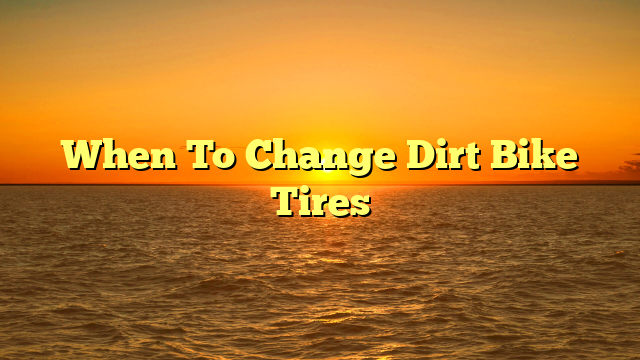As an avid cyclist, I know firsthand the importance of having functional and reliable bike tires.
When your tires start to wear down, it can lead to a number of safety hazards, including decreased traction and stability on the road.
That’s why it’s crucial to know when it’s time to replace your bike tires.
In this article, I’ll be discussing the signs that your tires need replacing, how to check the tire tread depth, how to identify visible damage and understand tire age and wear.
I’ll also be providing tips for maintaining your bike tires and choosing the right replacement tires to ensure safe and smooth rides.
So whether you’re a casual rider or a serious cyclist, read on to learn everything you need to know about when to replace your bike tires.
Table of Contents
- 1 Key Takeaways
- 2 The Importance of Bike Tires
- 3 Signs that Your Tires Need Replacing
- 4 Checking Tire Tread Depth
- 5 Identifying Visible Damage
- 6 Understanding Tire Age and Wear
- 7 Choosing the Right Replacement Tires
- 8 Tips for Maintaining Your Bike Tires
- 9 Ensuring Safe and Smooth Rides with New Tires
- 10 Frequently Asked Questions
- 10.1 How much air pressure should I have in my bike tires?
- 10.2 Can I replace just one tire or do I need to replace both at the same time?
- 10.3 Can I use any type of tire on my bike or do I need to use specific ones?
- 10.4 How often should I clean my bike tires?
- 10.5 Is it okay to ride on wet or slippery roads with my current tires?
- 11 Conclusion
Key Takeaways
- Regularly measure tread depth and check tire pressure to maintain optimal performance and safety.
- Visible damage should be inspected before each ride to prevent potential accidents.
- Choose the right replacement tires based on riding style and tire size.
- Replace bike tires every five years regardless of use to ensure safety on the road.
The Importance of Bike Tires
You can’t afford to underestimate the importance of your bike tires – they’re what keep you upright and able to ride safely.
One of the key factors to consider is tire pressure.
Having the correct tire pressure is crucial for maintaining control and preventing accidents while riding.
Low tire pressure can also lead to faster wear and tear on the tire, reducing its lifespan and requiring more frequent replacements.
Another important consideration is the type of tire you choose.
Different types of tires offer different benefits, such as increased traction, durability, or reduced rolling resistance.
For example, road bike tires are designed for speed and efficiency on smooth surfaces, while mountain bike tires are built to withstand rough terrain and provide better grip.
Understanding the benefits of different tire types can help you choose the best option for your riding style and needs.
Ultimately, investing in high-quality tires and maintaining proper tire pressure can make a significant difference in your safety and overall riding experience.
Signs that Your Tires Need Replacing
One indication that it’s time for new tires is if you notice a significant decrease in your bike’s performance on the road or trail.
If you find yourself struggling to maintain traction, or if you feel like you’re constantly fighting against resistance, it’s likely that your tires are worn out.
Assessing wear is an important skill to develop as a cyclist, as it can help you avoid potential accidents and improve your overall riding experience.
Another sign that your tires need replacing is the presence of punctures and cuts.
If you notice that your tires are frequently getting punctured or cut, it’s a good indication that they’re too thin and no longer provide adequate protection.
This can be particularly dangerous if you’re riding on rough terrain or at high speeds, as the increased risk of a blowout can lead to serious injury.
In general, it’s recommended that you replace your tires before they become too worn or damaged, in order to ensure that you’re always riding safely and comfortably.
Checking Tire Tread Depth
Assessing the depth of your tire treads is crucial for optimal performance and safety while cycling.
Here are some tips on how to measure your tire tread depth:
- Use a tire tread gauge: You can purchase this small tool at any bike shop or online retailer.
Simply place the gauge into the tread grooves and read the measurement displayed on the gauge.
- Check for wear indicators: Look for small raised bars that run perpendicular to the tread pattern.
Many tires have built-in wear indicators that show when the tread is getting too low.
- Use the penny test: Place a penny upside down into the tread grooves.
If Lincoln’s head is fully visible, it’s time to replace the tire.
In addition to measuring tread depth, it’s important to regularly check your tire pressure.
Properly inflated tires can prevent flats, improve handling, and extend the life of your tires.
Use a bike pump with a pressure gauge to ensure that your tires are inflated to the recommended pressure listed on the sidewall of the tire.
By regularly measuring tread depth and checking tire pressure, you can ensure that your bike is performing at its best.
Identifying Visible Damage
Spotting visible damage on your tires is crucial for ensuring safe and smooth rides on your bicycle.
Before even considering replacing your tire, it’s important to inspect it thoroughly for any visible signs of damage.
The inspecting process can be broken down into a few simple steps, such as checking for cuts, punctures, or bulges on the tire’s surface.
To make it easier to identify any visible damage, here’s a table outlining some common causes and their corresponding signs to watch out for:
| Common Cause | Signs of Damage |
|---|---|
| Wear and Tear | Cracks or splits on the sidewall or tread |
| Punctures | Holes or cuts in the tire surface |
| Impact damage | Bulges or deformities in the tire surface |
By regularly checking your bike tires for visible damage, you can avoid any potential accidents or issues that may arise from riding on a damaged tire.
Remember, prevention is always better than cure, so make it a habit to inspect your tires before each ride and replace them when necessary.
Understanding Tire Age and Wear
Understanding how long your bicycle tires can last and what factors contribute to their wear and tear is essential for maintaining your safety on the road.
One of the key factors to consider is tire age.
As a general rule, bike tires should be replaced every five years, regardless of use, as the rubber compound can degrade over time.
This is particularly important in areas with high UV exposure or extreme temperature fluctuations, which can accelerate the aging process.
Another important factor to consider is tire pressure.
Proper tire pressure not only ensures optimal performance, but it also helps to extend the life of your tires.
Underinflated tires can cause excessive wear on the sidewalls and tread, leading to premature failure.
Additionally, overinflated tires can also lead to reduced traction and a harsher ride, which can contribute to tire damage.
Understanding the appropriate pressure for your tires and checking it regularly will help to ensure that your tires are safe and long-lasting.
Finally, it’s important to pay attention to the rubber composition of your tires.
Different compounds can be used for different applications, such as harder compounds for durability or softer compounds for better grip.
Choosing the appropriate tire for your riding style and conditions can help to extend the life of your tires.
Choosing the Right Replacement Tires
Picking the perfect set of new tires for your trusty two-wheeler can be a fun and rewarding experience.
When it comes to choosing the right replacement tires, it’s important to consider the type of riding you’ll be doing.
For example, if you’re a road cyclist, you’ll want a tire that’s designed for high speed and low rolling resistance.
If you’re a mountain biker, you’ll want a tire that can handle rough terrain and provide plenty of traction.
Another important factor to consider is tire size.
The size of your tire will depend on the size of your bike’s wheels.
Most bikes use either 26-inch, 27.5-inch, or 29-inch wheels, and there are a variety of tire sizes to choose from within each category.
It’s important to choose the right size tire for your bike to ensure proper fit and performance.
When in doubt, consult your bike’s owner’s manual or speak with a knowledgeable bike shop employee to help you choose the right replacement tires.
Tips for Maintaining Your Bike Tires
To keep your rides smooth and enjoyable, you should make sure to maintain your bicycle tires regularly.
Here are some tips to help you maintain your bike tires and prevent any issues while you’re out on the road:
- Check your bike tire pressure regularly.
The recommended tire pressure is usually printed on the sidewall of the tire, so make sure to check this and inflate your tires accordingly.
Riding with underinflated tires can cause unnecessary wear and tear on the tires, which can lead to punctures and other issues.
- Keep your tires clean.
Dirt, debris, and other materials can accumulate on your tires, which can cause punctures and other issues.
Make sure to clean your tires regularly with a soft brush or cloth to remove any debris.
- Inspect your tires for damage.
Before every ride, make sure to inspect your tires for any cuts, punctures, or other damage.
If you notice any damage, you should replace the tire as soon as possible.
- Avoid riding on rough surfaces.
Riding on rough surfaces can cause unnecessary wear and tear on your tires, which can lead to punctures and other issues.
Try to avoid riding on rough surfaces as much as possible to prolong the life of your tires.
- Invest in puncture-resistant tires.
If you frequently ride in areas with a lot of debris or rough surfaces, it may be a good idea to invest in puncture-resistant tires.
These tires are designed to resist punctures and other forms of damage, which can help prolong the life of your tires.
By following these tips, you can help ensure that your bike tires stay in top condition.
This can help prevent punctures and other issues while you’re out on the road.
Remember to check your tire pressure regularly, keep your tires clean, inspect your tires for damage, avoid riding on rough surfaces, and invest in puncture-resistant tires if necessary.
Ensuring Safe and Smooth Rides with New Tires
Once you’ve purchased new tires, make sure you properly install them to ensure safe and smooth rides every time you hop on your bicycle.
Start by checking the recommended tire pressure, which is usually indicated on the sidewall of the tire.
Proper inflation is crucial for optimal performance, as under-inflated tires can lead to decreased speed and difficulty in handling your bike, while over-inflated tires can cause a rougher ride and may even lead to a blowout.
To ensure proper inflation, use a reliable tire pressure gauge and pump up your tires to the recommended pressure.
It’s also important to check your tire pressure regularly, as changes in temperature and riding conditions can affect the pressure.
A good rule of thumb is to check your tire pressure before each ride, especially if you haven’t ridden in a while.
With properly inflated tires, you’ll enjoy a smoother ride and better handling, while also reducing the risk of punctures and other damage to your tires.
Frequently Asked Questions
How much air pressure should I have in my bike tires?
I should aim for optimal inflation to ensure my bike handles well and rides smoothly.
Underinflation can cause increased rolling resistance and potential damage to the tire.
Different types of bikes have different air pressure requirements, so it’s important to consult the manufacturer’s recommendations.
Can I replace just one tire or do I need to replace both at the same time?
When replacing bike tires, it’s important to consider whether mismatched tires can cause safety issues.
While it’s possible to replace just one tire, it may not be cost effective in the long run.
It’s best to replace both at the same time for optimal performance.
Can I use any type of tire on my bike or do I need to use specific ones?
When selecting a tire for my bike, there are compatibility concerns to consider.
Certain tires may not fit properly or be appropriate for my riding style.
Pros and cons should be weighed before choosing a tire.
How often should I clean my bike tires?
I clean my bike tires after every ride using a soft brush and water.
I make sure to remove any dirt or debris that may have accumulated, and I inspect the tires for any signs of wear or damage.
Proper bike tire maintenance and cleaning techniques can help extend the life of your tires.
Is it okay to ride on wet or slippery roads with my current tires?
Riding on wet or slippery roads can be dangerous.
It’s important to have good tire tread for wet road safety.
Check the depth of your tire tread regularly and replace them when they become worn.
Conclusion
So, when should you replace your bike tires?
There are several signs to look out for, including worn tread depth, visible damage, and age.
It’s important to regularly check your tires and replace them as needed to ensure safe and smooth rides.
When choosing replacement tires, consider factors such as tire type, width, and tread pattern.
And don’t forget to maintain your tires by keeping them properly inflated and avoiding rough terrain.
With these tips in mind, you can enjoy your bike rides with confidence and peace of mind knowing your tires are in good condition.







